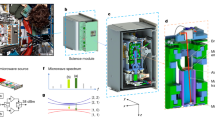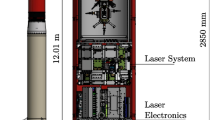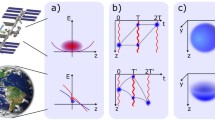Abstract
Atom interferometers have a multitude of proposed applications in space including precise measurements of the Earth’s gravitational field, in navigation & ranging, and in fundamental physics such as tests of the weak equivalence principle (WEP) and gravitational wave detection. While atom interferometers are realized routinely in ground-based laboratories, current efforts aim at the development of a space compatible design optimized with respect to dimensions, weight, power consumption, mechanical robustness and radiation hardness. In this paper, we present a design of a high-sensitivity differential dual species 85Rb/87Rb atom interferometer for space, including physics package, laser system, electronics and software. The physics package comprises the atom source consisting of dispensers and a 2D magneto-optical trap (MOT), the science chamber with a 3D-MOT, a magnetic trap based on an atom chip and an optical dipole trap (ODT) used for Bose-Einstein condensate (BEC) creation and interferometry, the detection unit, the vacuum system for 10−11 mbar ultra-high vacuum generation, and the high-suppression factor magnetic shielding as well as the thermal control system. The laser system is based on a hybrid approach using fiber-based telecom components and high-power laser diode technology and includes all laser sources for 2D-MOT, 3D-MOT, ODT, interferometry and detection. Manipulation and switching of the laser beams is carried out on an optical bench using Zerodur bonding technology. The instrument consists of 9 units with an overall mass of 221 kg, an average power consumption of 608 W (814 W peak), and a volume of 470 liters which would well fit on a satellite to be launched with a Soyuz rocket, as system studies have shown.























Similar content being viewed by others
References
Gauguet, A., et al.: Characterization and limits of a cold-atom Sagnac interferometer. Phys. Rev. A 80, 063604 (2009)
Müller, T., et al.: A compact atom interferometer gyroscope based on laser-cooled rubidium. Eur. Phys. J. D 53, 273–281 (2009)
Stockton, J.K., et al.: Absolute geodetic rotation measurement using atom interferometry. Phys. Rev. Lett. 107, 133001 (2011)
Tackmann, G., et al.: Self-alignment of a compact large-area atomic Sagnac interferometer. New. J. Phys. 14, 015002 (2012)
Canuel, B., et al.: Six-axis inertial sensor using cold-atom interferometry. Phys. Rev. Lett. 97, 010402 (2006)
Peters, A., et al.: Measurement of gravitational acceleration by dropping atoms. Nature 400, 849 (1999)
Louchet-Chauvet, A., et al.: The influence of transverse motion within an atomic gravimeter. New. J. Phys. 13, 065025 (2011)
McGuirk, J.M., et al.: Sensitive absolute-gravity gradiometry using atom interferometry. Phys. Rev. A 65, 033608 (2002)
Bonnin, A., et al.: Simultaneous dual-species matter-wave accelerometer. Phys. Rev. A 88, 043615 (2013)
Graham, P.W., et al.: A New method for gravitational wave detection with atomic sensors. Phys. Rev. Lett. 110, 171102 (2013)
Hogan, J.M., et al.: An atomic gravitational wave interferometric sensor in Low earth orbit (AGIS-LEO). Gen. Relativ. Gravit. 43, 1953–2009 (2011)
Drinkwater, M. R., et al.: GOCE: ESA’s first earth explorer core mission. In: Beutler, G. B. Drinkwater, M. Rummel, R. Steiger, R. (Eds.), Earth Gravity Field from Space - from Sensors to Earth Sciences. In the Space Sciences Series of ISSI, Vol. 18, 419–432, Kluwer Academic Publishers, Dordrecht, Netherlands, ISBN: 1-4020-1408-2 (2003)
Reigber, C. et al.: Earth gravity field and seasonal variability from CHAMP. In: Reigber, C. Lühr,H. Wickert, J. (Edss) Earth Observation with CHAMP – Results from Three Years in Orbit, Springer, Berlin, Heidelberg, New York, pp 25–30
Tapley, B. D. et al.: The gravity recovery and climate experiment: mission overview and early results, doi:10.1029/2004GL019779
Kohel, J. M. et al.: Quantum gravity gradiometer development for space, proc. of the sixth annual NASA science technology conference, ESTC (2006)
Carraz, O. et al., spaceborne gravity gradiometer concept based on cold atom interferometers for measuring earth’s gravity field, arXiv:1406.0765 (2014)
Dubois, J.-B. et al.: Microscope, a femto-g accelerometry mission: technologies and mission overview, Proceedings of the 4S Symposium: Small Satellite Systems and Services, Chia Laguna Sardinia, Italy, Sept. 25–29, 2006, ESA SP-618
STE-QUEST team: STE-QUEST Assessment Study Report (Yellow Book), ESA, http://sci.esa.int/ste-quest/53445-ste-quest-yellow-book (2013). Accessed 22 September 2014
Aguilera, D., et al.: STE-QUEST - test of the universality of free fall using cold atom interferometry. Class. Quantum. Grav. 31, 115010 (2014)
Hechenblaikner, G. et al.: STE-QUEST mission and system design. overview after completion of Phase-A, Exp. Astron., 2014, doi:10.1007/s10686-014-9373-6
Tino, G.M., et al.: Precision gravity tests with atom interferometry in space. Nucl. Physics B (Proc. Suppl.) 243–244, 203–217 (2013)
Abadie, J., et al.: All-sky search for gravitational-wave bursts in the first joint LIGO-GEO-Virgo run. Phys. Rev. D 81, 102001 (2010)
Danzmann, K. et al.: The gravitational universe, eLISA white paper
Schubert, C. et al.: Differential atom interferometry with 87Rb and 85Rb for testing the UFF in STE-QUEST, Preprint: arXiv:1312.5963v1 (2013)
Fray, S., et al.: Atomic interferometer with amplitude gratings of light and its applications to atom based tests of the equivalence principle. Phys. Rev. Lett. 93, 240404 (2004)
Biedermann, G.W., et al.: Low-noise simultaneous fluorescence detection of two atomic states. Opt. Lett. 34, 347 (2009)
Sorrentino, F., et al.: A compact atom interferometer for future space missions, microgravity. Sci. Technol 22(4), 551–561 (2010)
Sorrentino, F. et al.: The Space Atom Interferometer project: status and prospects, J. Physics. Conf. Series 327, 012050 (2011)
van Zoest, T., et al.: Bose-einstein condensation in microgravity. Science 328, 1540 (2010)
Rudolph, J., et al.: Degenerate quantum gases in microgravity. Micrograv. Sci. Technol. 23, 287 (2011)
Nyman, R.A. et al.: I.C.E.: A transportable atomic inertial sensor for test in microgravity, Appl. Phys. B. 84, 673, (2006)
Geiger, R., et al.: Detecting inertial effects with airborne matter-wave interferometry. Nat. Comm. 2, 474 (2011)
Müntinga, H., et al.: Interferometry with Bose-Einstein condensates in microgravity. Phys. Rev. Lett. 110, 093602 (2013)
Dieckmann, K., et al.: Two-dimensional magneto-optical trap as a source of slow atoms. Phys. Rev. A 58(5), 3891 (1998)
Website: http://smsc.cnes.fr/PHARAO/
Laurent, P., et al.: Design of the cold atom PHARAO space clock and initial test results. Appl. Phys. B 84, 683 (2006)
Herr, W.: Eine kompakte Quelle quantenentarteter Gase hohen Flusses für die Atominterferometrie unter Schwerelosigkeit, PhD-thesis at Leibniz Universität Hannover (2013)
Clément, J.-F. et al.: All-optical runaway evaporation to bose-einstein condensation. Phys. Rev. Lett. 79, 061406 (R) (2009)
Altin, P.A., et al.: 85Rb tunable-interaction Bose–einstein condensate machine. Rev. Sci. Instrum. 81, 063103 (2010)
Lévèque, T., et al.: Enhancing the area of a Raman atom interferometer using a versatile double-diffraction technique. Phys. Rev. Lett. 103, 080405 (2009)
Website: www.zygo.com – optical mirrors
Website: www.cedrat-technologies.com – DTT35XS: A new compact piezo tilt mechanism with 3° of freedom., R. Le Letty et al.: Miniature piezo mechanisms for optical and space applications, ACTUATOR 2004, 9th International Conference on New Actuators, 14 – 16 June 2004, Bremen, Germany
Rocco, E. et al.: Atom shot noise detection for atom interferometry, in preparation
Milke, A., et al.: Atom interferometry in space: thermal management and magnetic shielding. Rev. Sci. Instrum. 85, 083105 (2014)
Mateos, I., et al.: Temperature coefficient improvement for low noise magnetic measurements in LISA. J. Phys. Conf. Ser 363, 012051 (2012)
Mateos, I., et al.: Magnetic back action effect of magnetic sensors for eLISA/NGO. ASP Conf Ser. 467, 341 (2013)
Website: www.ansys.com – Official website of ANSYS, Inc.
Website: www.techapps.com – Producer of space qualified carbon fiber heat straps. Technol Appl. Inc.
Lévèque, T., et al.: A laser setup for rubidium cooling dedicated to space applications. Appl. Phys. B 116, 997 (2014)
Luvsandamdin, E., et al.: Development of narrow linewidth, micro-integrated extended cavity diode lasers for quantum optics experiments in space. Appl. Phys. B. 111, 255–260 (2013)
Luvsandamdin, E., et al.: Micro-integrated extended cavity diode lasers for precision potassium spectroscopy in space. Opt. Express 22(7), 7790–7798 (2014)
Kuhn, C. C. N. et al.: A Bose-condensed, simultaneous dual species Mach-Zehnder atom interferometer, arXiv:1401.5827 (2014)
Duncker, H., et al.: Ultrastable, Zerodur based optical benches for quantum gas experiments. Appl. Opt. 53(20), 4468–4474 (2014)
Website: http://www.rtems.org
See website: http://vijaysamyal.tripod.com/YOURDAN_SAD.pdf
Nyman, R.A., et al.: I.C.E.: a transportable atomic inertial sensor for test in microgravity. Appl. Phys. B 84, 673 (2006)
Acknowledgments
This work was supported by the German space agency Deutsches Zentrum für Luft- und Raumfahrt (DLR) with funds provided by the Federal Ministry of Economics and Technology under grant numbers 50 OY 1302, 50 OY 1303, and 50 OY 1304, the German Research Foundation (DFG) by funding the Cluster of Excellence “Centre for Quantum Engineering and Space-Time Research (QUEST)”, the French Space Agency Centre National d'Etudes Spatiales, and the European Space Agency (ESA). Lluis Gesa, Ignacio Mateos and Carlos F. Sopuerta acknowledge support from Grants AYA-2010-15709 (MICINN), 2009-SGR-935 (AGAUR) and ESP2013-47637-P (MINECO). Kai Bongs acknowledges support from UKSA for the UK contribution. Baptiste Battelier, Andrea Bertoldi and Philippe Bouyer thank the “Agence Nationale pour la Recherche” for support within the MINIATOM project (ANR-09-BLAN-0026). Wolf von Klitzing acknowledges support from the Future and Emerging Technologies (FET) programme of the EU (MatterWave, FP7-ICT-601180).
Author information
Authors and Affiliations
Corresponding author
Rights and permissions
About this article
Cite this article
Schuldt, T., Schubert, C., Krutzik, M. et al. Design of a dual species atom interferometer for space. Exp Astron 39, 167–206 (2015). https://doi.org/10.1007/s10686-014-9433-y
Received:
Accepted:
Published:
Issue Date:
DOI: https://doi.org/10.1007/s10686-014-9433-y




